The Garlic Mustard Enigma
By Rosanne Lindsay, Traditional Naturopath
Spring has sprung! ‘Tis the season of new growth, birdsong, and the pulling of garlic mustard! For those not interested in an interlude into the “weeds,” you can stop reading now.
I offer a brief segue to speak for the plants. Because soon, people will become activists in large groups to pull a plant called garlic mustard (Alliaria petiolata) out of the ground to end its life. Why has this tradition taken root in the greater part of the U.S., before this plant sets seed?
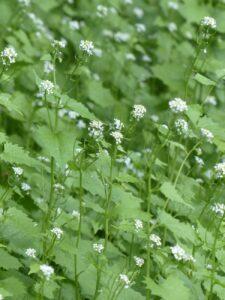 Did Nature get it wrong?
Did Nature get it wrong?
Or is garlic mustard misunderstood?
What is a Weed?
Herbalists know that no plant is a “weed,” since each plant has a purpose. Weeds do not exist in Nature. According to medical anthropologist Ben Belek:
Weeds don’t exist in the wild. They can’t exist. A weed is only a weed when an onlooker says it is. The property of weediness, I reflected, is little more than herbage out of place. Only when a hardworking farmer extends her field to make room for a cauliflower patch, does the hitherto wild flora that lived and thrived there suddenly transform into a nuisance. Only with foreign settlement, does indigeneity become adversarial.
If people uproot garlic mustard, it is because they are convinced it is a non-native, invasive plant. End of discussion. However, if we can align ourselves with the plant kingdom, then we can better understand them. We are not so different from our plant allies. Most humans are transplants. When humans are forced to leave their home, it is called eminent domain.
If Ends of Discussions do not sit right with you, then you might be a contrarian! You might align with garlic mustard, the contrarian of the plant world! Any good contrarian, anyone who rejects popular opinion, would not let the discussion end.
Our Nature Is Nature
Pulling garlic mustard where it is abundant prolongs its run. It also robs a great deal of nitrogen, macro- and micronutrients, and organic matter from the ecosystem.— Dr. Berndt Blossey, Cornell University
As we have begun this discussion, let us continue with some basic definitions that humans ascribe to the plant kingdom.
Invasive plants are plants that have been introduced to an ecosystem and are poised to take over. According to Naturalists, invasive plants have aggressive root systems that spread long distances. They may smother other plants in the area. Some produce chemicals which impact the growth of plants around them. Basically, these plants dominate and some claims they don’t offer the benefits to local fauna. [There are politicians who qualify as invasive.]
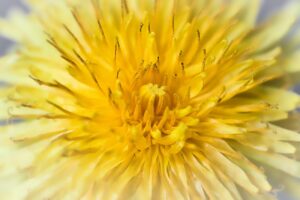 Consider the Dandelion (Taxacum officinale), a transplant from “somewhere else” that has naturalized itself in every part of the world but Antarctica! Sound similar to human migration? Today, the dandelion is listed as invasive only in Oregon and Alaska. Perhaps more people have come to appreciate her gifts and place in the world.
Consider the Dandelion (Taxacum officinale), a transplant from “somewhere else” that has naturalized itself in every part of the world but Antarctica! Sound similar to human migration? Today, the dandelion is listed as invasive only in Oregon and Alaska. Perhaps more people have come to appreciate her gifts and place in the world.
Dandelions were once native to Eurasia, before they have become native everywhere. It is generally believed that the dandelion was first brought to North America on the Mayflower for its medicinal uses. In Europe, China, India and Russia dandelions were used to treat skin, infection, liver (root), kidneys (leaf) and digestive problems (the root balances HCL, aids constipation).
In Chinese Medicine, liver is known to be the seat of anger. Thus, dandelion leaves and roots help to detoxify an angry liver. As a flower essence, the sunny countenance of the dandelion works with the solar plexus to release trauma related to fears, ego, self worth, and personal power.
Non-native plants are also introduced plants, but they don’t have the negative reputation that invasive plants do. They could produce foliage or blooms that benefit local wildlife and they don’t take over their habitat. Dandelion qualifies here, too.
Native plants are well adapted to survive in their environment. They typically need less water, less fertilizing, and overall less care to fit in and thrive. Stay long enough in one place, and plants qualify as “native.”
Over time, the dandelion has gathered many names from the locals. In the case of the solar, resilient dandelion, she is known as all three: “native, non-native, invasive.” Beyond human classification, her flowers make a tasty jelly, while her roots make a great coffee alternative as a tea.
Garlic Mustard Misunderstood
Garlic mustard (Alliaria petiolata), too, has a lot to offer humanity. However, she is called pernicious, exotic, and a Class A noxious weed on a list of plants to be controlled. That’s a lot to overcome. With all the publicity, this plant that has captured the attention of plant lovers and haters, alike. Insults aside, who is she really?
A member of the cabbage and broccoli family (Brassicaceae), garlic mustard grows 2-3 (up to 6) feet tall all over the Northeast and Midwest U.S. Lower leaves are kidney-shaped with scalloped edges. In spring, roots and new leaves smell like garlic, and small, four-petal white flowers appear clustered at stem ends, followed by long, skinny seedpods.
The family Brassicacea does not consider her evil. As a medicinal, the leaves and stems of garlic mustard are: antiasthmatic, antiscorbutic, antiseptic, deobstruent, diaphoretic, vermifuge and vulnerary.
According to Maude Grieve’s, A Modern Herbal, “The leaves used to be taken internally as a sudorific and deobstruent, to promote sweating and to treat bronchitis, asthma and eczema. Externally, leaves are antiseptic in gangrenes and ulcers, and against itching caused by bites and stings. The juice of the leaves taken alone or boiled into a syrup with honey is found serviceable in dropsy. The herb, when eaten as a salad, warms the stomach and strengthens the digestive faculties. The seeds have been used as a snuff to excite sneezing.”
This plant has the spicy tang of mustard with a hint of garlic, and can be used as a base for pesto and sauces, and to flavor salads, soups and other dishes. That qualifies as sassy, not noxious.
However, eating her leaves has not worked well as a control strategy. Plant stands can produce more than 62,000 seeds per square meter, and can self-pollinate, which helps it rapidly spread, to displace native plants along trails, in forests, and on riverbanks.
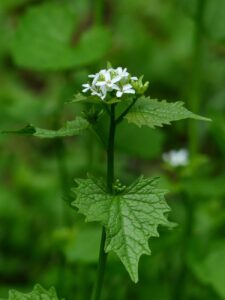 Out of the way, garlic mustard minds her own business, perfectly happy in a group, not bothering anyone, friend to the deer. After all, in the wilds of Nature, plants with such a bad reputation must work in creative ways to survive.
Out of the way, garlic mustard minds her own business, perfectly happy in a group, not bothering anyone, friend to the deer. After all, in the wilds of Nature, plants with such a bad reputation must work in creative ways to survive.
Self-Regulating Life Style
To survive, garlic mustard populations secrete a compound called sinigrin, a chemical that deters the growth of other plants and decreases competition. In 2016, researchers at the University of Illinois found that within three decades, “sinigrin concentrations decrease as garlic mustard populations age, demonstrating evolutionary change due to ecological processes.” Garlic mustard declines when it reaches a balance with native species that re-colonize invaded areas.
One of the things we’ve seen over the last 20 to 30 years is that garlic mustard becomes less of an issue, and actually balances out over time.—Adam Davis, ecologist, U of I, and USDA Agricultural Research Service
Garlic mustard is self-regulating. Its life cycle runs about 20-30 years. As the plants age, they die off completely. Other species are then able to move back in.
If humans were to look closer to garlic mustard’s example, we might find we are not so different. Nature is self-regulating, just as we are.
The more deer in the area, the more garlic mustard. The deer are forced to eat the garlic mustard instead of the native plant species. Garlic mustard plays a role in defense of the collective plant world.
Doing Less is More
A decade-long Cornell University study of garlic mustard has shown that avoidance is the best way to manage garlic mustard. Conservation biologist, Dr. Berndt Blossey, says:
Pulling up large swaths of garlic mustard is not only futile, it is worse than leaving it alone. It bears echoing: When well-intentioned people rip out this stuff, it actually prolongs the infestation period because the plant self-limits (more on that below) if undisturbed. Also, these mass garlic mustard-ectomy events do more damage to the ecosystem than the target species itself does. —Dr. Berndt Blossey
The study found (see video): “Side-by-side controlled trials showed that where garlic mustard is “managed,” the plants are considerably larger, and cover a much higher percentage of a site (at times by an order of magnitude) than the sections where nothing has been done. Not only that, but biomass on the managed sites tended to be roughly stable over the ten-year time frame studied, whereas it declined year after year in the unmanaged plots.”
Blossey says people wrongly conclude that “maple sap flows up from the roots during the day; goldenrod causes allergy symptoms; and garlic mustard wipes out native wildflowers and adversely affects salamanders.” Upon closer examination, these conclusions are demonstrably 100% false:
It turns out that while garlic mustard competes with native species, it does not displace them where deer are excluded or drastically reduced in number. And it is earthworms, not our maligned invasive plant, which make a neighborhood less attractive to salamanders. —Dr. Berndt Blossey
Though it appears that garlic mustard displaces native vegetation with its prolific growth, what is really going on is a lack of cultivation of those native species.
Nature teaches that one can have intellect but not wisdom. Wisdom is not a group activity. When it comes to the ways of garlic mustard, wisdom beats activism.
Culinary Benefits of Garlic Mustard
Why not eat the Invasives?
Garlic mustard has not only established herself in Nature, as food for deer, but is well known in foraging and culinary circles, and thus, local human economies. You can collect and dry the seeds of garlic mustard to make your own garlic mustard edibles, mayonnaise or dairy-free ranch dressing. You can also purchase pre-made mustard.
Or take a hint from the Forager Chef and make yourself some garlic mustard shoots with ramp butter! Just make sure you harvest the ramps responsibly, as forager and author, Sam Thayer teaches!
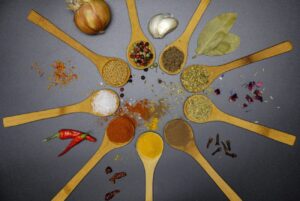 According to Pascal Baudar, author of Wildcrafted Fermentation, a book about lacto fermentation of common wild edibles, stone ground black mustard seeds (Brassica nigra) make plant-based cheeses, fermenting mushrooms, sauces, soups, condiments, and more. Baudar says:
According to Pascal Baudar, author of Wildcrafted Fermentation, a book about lacto fermentation of common wild edibles, stone ground black mustard seeds (Brassica nigra) make plant-based cheeses, fermenting mushrooms, sauces, soups, condiments, and more. Baudar says:
I don’t know why this resource is simply wasted, an L.A. Times article from 2019 called the plant “evil” because it covers our local hills. With such narrative, you’re going nowhere in terms of positive solutions. I wish the city had a special program to look at culinary solutions for the abundant wild food surrounding us.
I mean, instead of spending money on chemicals you probably could make money selling gourmet organic mustard with the profit going back to helping the environment. Why not? Some people would make a point to buy it.
Of course, in spring time you can also do all kinds of recipe with the leaves and flowers. I think it’s much more creative than spraying Round-Up or wasting this delicious “unwanted” resource by throwing it away.Organic all the way.
Bauder shares garlic mustard recipes on his June 15, 2022 post Facebook page: “These days, I use a different technique. I soak the seeds for 3 days in a mix of 2 parts vinegar and 1 part wine and was able to make this wild “Dijon” mustard in 5 minutes during a class last weekend. Those “Invasive” plants can truly be gourmet food and so easy to procure. It took me 30 minutes to gather enough seeds to fill nearly 2 cups.
Be Like Garlic Mustard
If you have stood by, wondering why people expend so much time and energy on digging up plants in the wild, without understanding their unique qualities, then you, too, are a contrarian. Why not celebrate this unique quality with some garlic mustard, and dandelion tea?


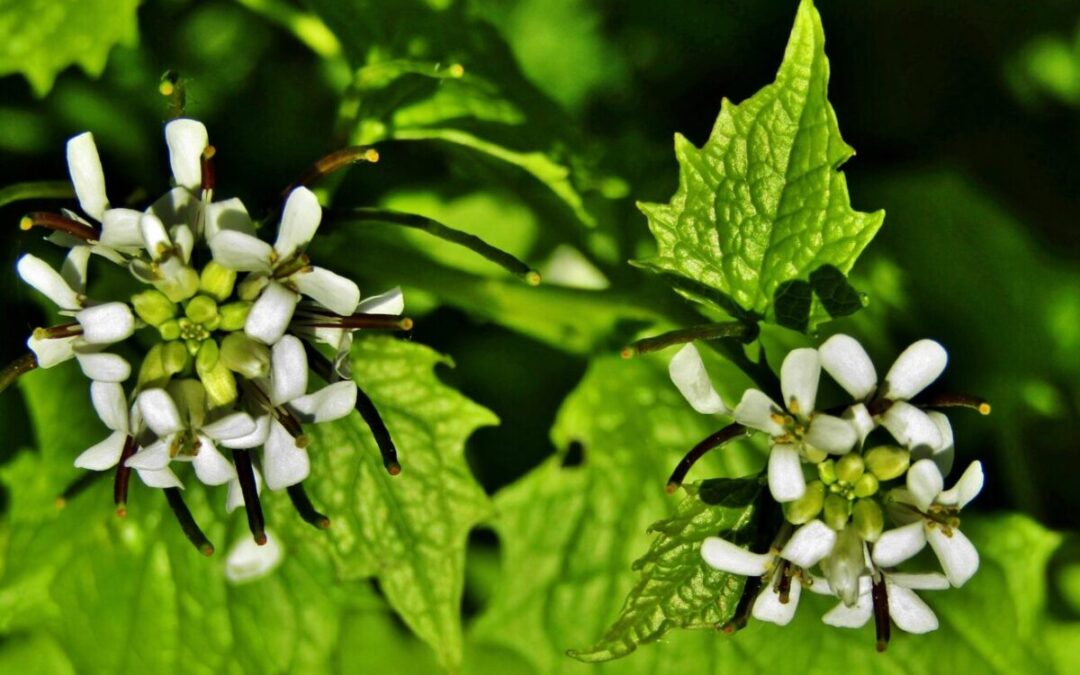
 natureofhealing.org
natureofhealing.org












